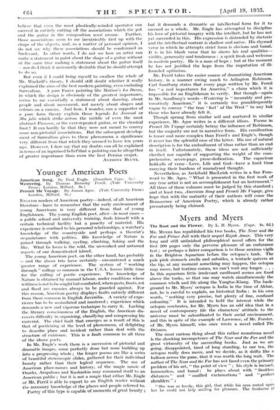Myers and Myers
The Root and the Flower. By L. H. Myers. (Cape. Ss. 6d.)
MR. MYERS has republished his two books, The Near and the Far and Prince Jail with their sequel Rajah Amar. This very long and still unfinished philosophical novel offers for the first 200 pages only. the perverse pleasure of an endurance test ; or perhaps a fairer comparison is to those anxious vigils in the Brighton Aquarium before the octopus's tank. The pale pink stomach swells and subsides, a tentacle quivers at the tip, at any moment something may happen, the octopus may move,-but teatime comes, we. can't wait any longer.. . . In this aquarium little irrelevant cardboard scenes are fixed above the tanks, so that one may watch simultaneously the common whelk and life along the Yangtse-Kiang. The back- ground to Mr. Myers' octopus is India in the time of Akbar, not, he is careful to explain, an historical India : in his own words, " nothing very precise, but plenty of fine, confused colouring." It is intended to hold the interest- while the octopus cerebrates, for Mr. Myers has an odd idea that in a novel of contemporary life the characters' attitude to the universe must be subordinated to their social environment, and this in spite of the example of Lawrence, of Mr. Forster, of Mr. Myers himself, who once wrote a novel called The Orissers. , The most curious thing about this rather monstrous novel is the shocking incompetence of The Near and the Far and the great virtuosity. of the succeeding books. Just as we are going, disappointed, tired of long standing, to our tea, the octopus really does move, and we decide, as it drifts like a balloon across the pane, that it was worth the long wait. The author of The Near and the Far has not faced even the primary problem of his art, " the point of view " ; his style is inexact, humourless, and banal ; he plays about with " limitless -distances " and muffled exclamations " and " perfect shoulders " " She was so lovely, this girl, that while his eyes rested upon her he could not help smiling for pleasure. The freshness • Of childhood was still hers ; what her last year had added was softness and bloom and a depth of luminous secrecy behind the eyes—those eyes that veiled—and in so doing betrayed—a conscious- pass of sex and beauty. As now she moved into a sitting posture, her light garment falling away, revealed a perfect neck and shoulders."
It is hard to believe that the writer of this passage, embarrass- ing even to type, is also the author of the amusing and accurate description of Rajah Amah's picture : " By a curious piece of good fortune a portrait of the Rajah is extant. It is the product of a rather poor Persian artist., working cithout imagination within the limits of a strict convention. He shows us his royal subject standing stiffly in full dress uniform in .-hat is probably a deer-park. The park is full of innocent animals—we notice in particular a lamb prancing in a little patch of flowers in the background. The Rajah-faces us with a look of supreme detachment—he seems, indeed, completely absent from t he earthly scene ; and yet in one hand he holds a piece of sugar— or is it salt 1—which he is offering to a doe. This creature the artist has succeeded in investing with an air of extraordinary respect- fulness—so much so that she seems to be on the point of dropping a curtsey. A picture of more skill and sophistication might well have been less revealing ; " that he is the author whose virtuosity is beautifully seen in the creation of Prince Daniyal, ruler of the sinister Pleasaunce of Art, with its homo-sexuals and amateur actors and shrill voices and terrible triviality, whom Mr. Myers cleverly contrives to fit into the Indian scene while retaining his importance as a contemporary symbol.
" While a great deal is made of aesthetic sensibility and its refinements, we hear very little about moral sensibility. It is ignored ; and the deep seated vulgarity that commonly lies at the heart of our civilization commonly passes without notice."
The conception of the Rajah, with his cynical purity and his hopeless idealism, and of his tragic child Jali, who " was condemned by some inexplicable law of his own nature to do himself unceasing outrage," is admirable, and their story deserves a less clumsy overture. One judges The Root and the Flower as a novel because good philosophy cannot save a bad novel nor bad philosophy ruin a good novel ; a novelist t be judged by his ability to dramatize his ideas. Prince Jail and Rajah Amar arc successful dramatizations, while The Near and the Far is a weak abandonment to what James called
the platitude of statement." GRAHAM GREENE.







































 Previous page
Previous page